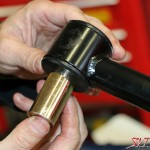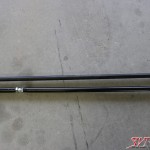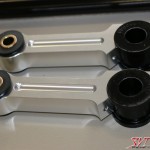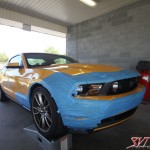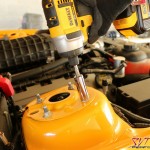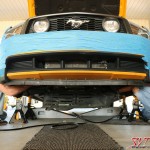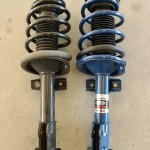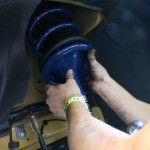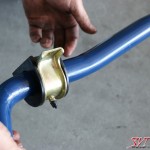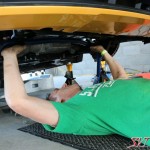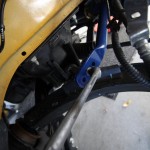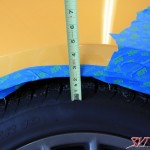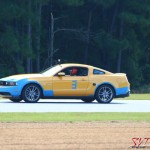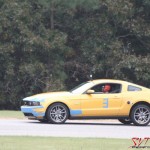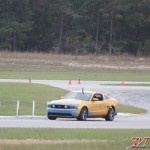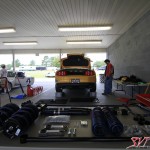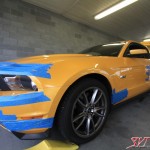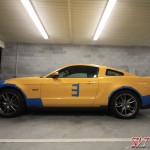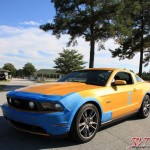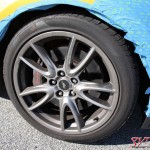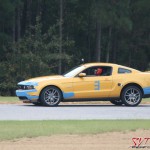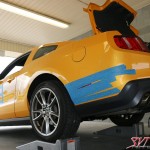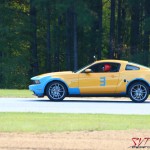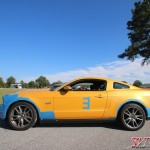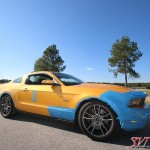Package Deal
Installing and testing Ford Racing’s FR3 suspension on the SVTP GT—at the track!
By SID297
Photos by StacyStangz
If you haven’t been following the progress of the SVTP GT, it’s 5.0 is topped by a 2.3-liter TVS-based Magnuson supercharger system that—with the help of a custom cold-air intake—produced 576 rear-wheel horsepower with a measly 7 pounds of boost. Since it makes plenty of power, we shifted our focus to improving its handling. That’s where our good friends at Ford Racing Performance Parts came in.

While in Detroit to drive the outstanding Ford Fiesta ST, we stopped by Ford Racing for a meeting. There we discussed working on some projects with Ford Racing Performance Parts gear. That’s when we hit on the idea to install Ford Racing’s adjustable FR3 suspension kit for the S197 Mustangs. Certainly our powerhouse project could use a bit more cornering prowess.
However, this being SVTP, a simple install article just wouldn’t do. We had to spice things up a bit. So we decided to do before and after testing at Carolina Motorsports Park in Kershaw, South Carolina, with a twist; we would also do the install at the track. That’s right, we’re essentially going to R&R a Mustang suspension in the paddock at CMP.

Some might say that’s an awesome idea, some might say it was a bold undertaking. Others still might say that it was sheer insanity. They might all be right. The thing to keep in mind is that this is SVTP, so we don’t do anything halfway. If it’s worth doing it’s worth overdoing. Installing a suspension is cool. Installing a suspension at the track is awesome.
So that’s what we set out to do. We loaded the SVTP trailer with all the provisions (mostly tools and steaks) we would need for a weekend of mechanical work at the track. The day began with us departing Myrtle Beach, South Carolina, in the SVTP F-350 at 6:00 a.m. and arriving at CMP about three hours later. From there it was time to go through tech and get ready for our first session of the day.

The car was fueled, the tires were properly inflated, and the interior was devoid of objects that could become projectiles should the session end badly. This was my first time on the track in the SVTP GT, and I knew that with nearly 600 rwhp, a mere blip of the throttle away the tires and brakes would be the true limiting factors of the day.
After a solid warm up lab we started to lean on the car a bit more and found that it leaned right back quite a bit. The SVTP GT features the Brembo package, which comes with a more track-oriented suspension than the base Mustang GT, but it still exhibited a surprising amount of body roll. The suspension felt much softer on turn-in than you might expect from a performance-optioned Mustang.

The relative softness of the stock suspension resulted in mixed feelings about the overall track experience with the car. First, it makes the turn-in feel deceptive, which resulted feeding in more steering input than me actually needed. It’s hard to explain, but it really causes a disconnected feeling between steering wheel input and the front wheels. The softness also does nothing to help your confidence for carrying speed through a turn.
With the amount of body roll the car exhibited, you tend not to feel inspired to keep pushing the car harder either. On transitions you always have the thought of snap-back oversteer on your mind. You know that if the weight transfers too suddenly from one corner of the car to another that you’re really going to end up with a handful. In the plus column though, the stock suspension is quite forgiving if you get a bit to aggressive in a turn and start to climb a berm or happen to clip a rumble-strip.

However, just as we had always known, the limiting component of the car at CMP was the tires. We were taking it easy on the stock brake pads by limiting our speed, but the stock Pirelli tires are certainly not capable of keeping up with the rest of the car. Still, it’s the stock suspension’s interaction with the tires that proves to be most interesting. Because of the relative sponginess of the stock springs you almost always experience a delay in what you’re commanding the car to do and what it is actually doing. This can be a real problem at the limit, because once you sense that the car is about to step out, you may be left without enough time to correct it. Worst yet, your corrections could be delayed to the point where they only exacerbate the situation.
So with that whole uninspiring track experience under our belts we headed in the paddock at started what most of our stall-mates considered crazy—the removal and replacement of an entire suspension. The FRPP FR3 system is an extremely complete kit that saw an interesting update last year. Instead of being shipped as separate components, the front struts now come fully assembled. You no longer have to concern yourself with procuring and mastering a spring compressor tool; a tool, which can be dangerous if misused. Instead, it’s now simply a matter of removing the stock strut assemblies and reinstalling the FRPP pieces.

For those of you who may not be aware of the details of the Ford Racing FR3 suspension for the S197 Mustangs, you may want to pay attention. It is basically as complete a kit, as you will find anywhere. With it you receive upgraded sway bars featuring polyurethane bushings; an adjustable rear Panhard bar; stiffer springs; and adjustable dampers to dial in you desired level of performance. Combined, these components add up to one serious suspension upgrade.
You might wonder, “How does this kit differ from the previous version?†That’s where the fully assembled front struts come into play. That single change allows this kit to be installed with nothing more than simple hand tools, a floor jack, and a couple of jack stands. While we might have employed a few other tools, they’re nothing that the average gearhead shouldn’t have at his disposal.

After an evening of wrenching and a plate full of hash browns we were ready to stretch the SVTP GT’s newly installed legs. The first order of business was a little shakedown cruise through the pits to make sure everything was cinched down properly. Satisfied that the car wasn’t going to come apart in the kinks we headed out on the track to see what kind of difference a day of work and some help from Ford Racing had made.
From the first time we turned the wheel we were rewarded with a much different car. The Ford Racing suspension had lowered and tightened the chassis to a surprising degree. Turn-in at every point was much quicker than was ever possible with the stock suspension. The car now responded to steering input with a fervor that only seemed limited by the factory rubber. The fear of snap oversteer had evaporated into the ether along with the intrusive feeling of body-roll. The car now felt collected, and help instill a sense of confidence in its driver to a degree that was simply not possible with the OEM equipment.

At every point through a turn the transition between control and catastrophe seemed to grow more linear and predictable. No longer did you feel that at the first hint of lost traction that you were mere milliseconds away from an off-track experience better left to an SVT Raptor. Instead, the chassis and tires seemed to respond to the driver’s input in a way that allowed you to ride on the edge of a spin without crossing that undesirable threshold.
To put it succinctly: the car cornered much flatter, offered more direct feedback, better complied to steering inputs and corrections, and instilled a sense of driving confidence that could not be found with the factory hardware.

Even if you don’t track your car, there are enough street-level benefits to be found in FRPP’s suspension. For starters, we found that the Ford Racing kit lowered the Brembo-equipped SVTP GT about 1 inch all the way around. I never really felt the car had a bad stance from the factory, but the drop delivered by FRPP’s hardware made it look even better. While not an issue for the SVTP GT, if your pony car is suffering from 4×4-ride-height-syndrome this kit may just be the cure to your woes.
Further, the on-street manners and ride comfort were not adversely affected. True, the overall ride is a bit stiffer; but it is in no way harsh or intrusive. A firmer ride was to be expected, and in our case welcomed. I was never a huge fan of the way this particular car rode. It was sporty, but always seemed a bit too “pedestrian†to me. I prefer the road manners of a Boss 302 LS, and that’s what the Ford Racing kit delivers.

Tough handling and quick rebound are the hallmarks of this system. No long do you have that minute delay of an unsettled rear suspension finding its place. With the FR3 kit, recovery from hitting a road imperfection is nearly instantaneous. In fact, it your tires are up to the task you will feel an ability to get into, and stay in, the throttle to a much greater degree than would ever be possible with the stock suspension.
To say we’re pleased with the Ford Racing FR3 suspension is an understatement. The SVTP GT no longer wallows about, brake induced nose-dive has been significantly curtailed, and WOT nose-rise has decreased by a substantial degree. In my ever so humble opinion, everything about this kit is superior to the stock suspension.
For those of us who were not fortunate enough to buy a Boss LS, this kit can bring your car one step closer to Boss-level Performance. Thanks to the change to fully assembled struts the installation of the FR3 system is exceedingly simple. There’s no reason that two competent modders couldn’t knock out the install in about 4 to 5 hours with a jack and jackstands in your driveway, without the need for specialty tools.

The Ford Racing FR3 Suspension System is a great functioning easy to install kit that should be considered by anyone looking to drop their Mustang an inch while simultaneously increasing performance and driving enjoyment.
It’s a win-win all around, and has us really excited to see what the guys at Ford Racing have coming down the pike for the S550 Mustangs.

